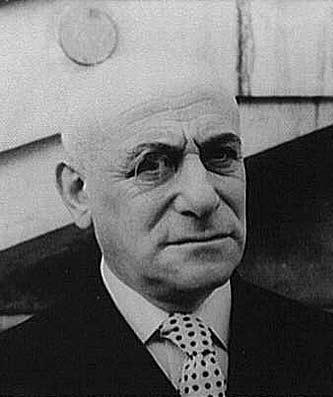Max Jacob

The future poet was born in Quimper (Finistère department) on 12 July 1876, into a Jewish family from Prussia. In 1888 the family changed its name from Alexandre to Jacob.
Being the son of a tailor, his studies at the Lycée in Quimper, his 8th place in the Concours Général in philosophy and his admission to the colonial school did not seem to predispose him to the life of an artist that he took up in 1897 when he moved to Paris. He was attracted by the spirit of the latest artistic trends, he met Picasso in 1901 and spent much time with the artists at the "Bateau-Lavoir", where he also took up residence in 1911. In 1903, he published “The Story of King Kabul the First and Gawain the Kitchen Boy”.
Many of his works were illustrated by his friends: Derain for the Brother Matorel burlesque and mystic works, Pablo Picasso for “The siege of Jerusalem”, Juan Gris for “Ne coupez pas mademoiselle,” etc.
He converted to Catholicism in 1909, and was baptised on 18 February 1915 at the Couvent de Sion in Paris. Picasso was his godfather. He was found unfit for combat and did not take part in World War I, and in 1916-1917 he adopted surrealism, writing “The Dice Box”.
In 1921, he decided to retire to a monastery in Saint-Benoît-sur-Loire. In prose and verse poetry, Max Jacob continued to give free rein to his irony and his sensitivity, in a collision of images and words reaching burlesque levels.
"Les manèges déménagent,
Ah ! Vers quels mirages ?
Dites pour quels voyages
Les manèges déménagent."
(Pour les enfants et les raffinés)
“Le Laboratoire central”, “La Couronne de Voltaire” and “Visions infernales” were published between 1921 and 1924. But in 1927, he returned to Paris, the capital of what may have been the richest literary life of the 20th century and the centre of artistic battles. He stayed there for nine years before returning to the Loiret department, writing, reciting his poems and exhibiting his watercolours at the gallery that Christian Dior had just opened.
War – which he had avoided twenty years earlier – caught up with him in the form of the anti-Jewish measures. In 1943, his brother Gaston was deported. Then his sister, Mirthé-Léa, at the beginning of 1944. On 24 February 1944, Max Jacob was arrested and taken to the prison in Orléans. He was transferred to the Drancy camp on 28 February and died there of pneumonia on 5 March. He was buried at the Ivry cemetery, then his body was moved to Saint-Benoît-sur-Loire on 5 March 1949.
"Le Paradis est la ligne de craie
sur le tableau noir de ta vie V
as-lu l'effacer avec les diables
de ce temps ?"
(Folklore)

